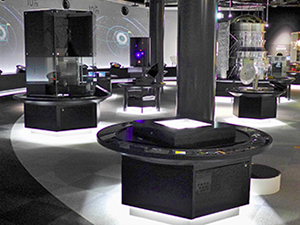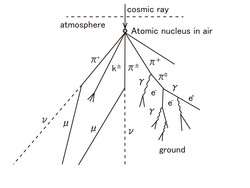Nagoya City Science Museum
TOP > Exhibition Guide > Keyword Search > Starting with "S" > space > Detecting Cosmic Rays
Detecting Cosmic Rays

Purpose of Exhibition
Electrons and nuclei are raining down on the earth from every direction of the Universe. They are a kind of radiation called cosmic rays.
Let’s take a look at this exhibit and find out the evidence of cosmic rays traveling through this place at this very moment. Blue flashes in the chamber are the traces of cosmic rays. You can see how many cosmic rays pass through the box in a minute. Just like this box, cosmic rays are also going through your body.


Additional Knowledge
[Secondary Cosmic Rays: Newly Produced in the Upper Atmosphere]
Cosmic rays from outside the earth (primary cosmic rays), however, do not reach the surface by themselves. Instead, they collide with air in the upper atmosphere and produce new cosmic rays. The original cosmic rays strike the earth’s atmosphere at almost the speed of light and cause a nuclear reaction with the atoms in the air, knocking out neutrons and protons from the nuclei and simultaneously emitting muons and other particles. These are called secondary cosmic rays, and which then penetrate your body.
[Why Can Muons Reach the Ground?]
Muons are extremely unstable, with a lifetime of only about half a millionth of a second. During such a short period of time, even light should travel only about 600m. So, you would say that muons generated high in the atmosphere could never reach the ground, before spontaneously decaying. But indeed, as muons move at very close to the speed of light, relativistic time dilation extends their lifetime from the perspective of the earth. Consequently, they can travel farther than you might have expected, and make it all the way to the earth’s surface.
[How to See Cosmic Rays]
Our eyes cannot see cosmic rays as they are. Now, let me show you how this exhibit makes the invisible visible.
・Spark Chamber
At the back left of the photo is a spark chamber. This device has uniformly separated metal plates in the sealed box, which is filled with helium. As a cosmic ray crosses the gas box, it leaves a trail of ionized helium atoms. At that instant, high voltage is applied to the plates, and blue-white sparks jump along the trajectory of the ray. In short, the moment cosmic rays are detected, high voltage makes them visible to our eyes.
The device has two radiation detectors called scintillation counters (which work as cosmic ray detectors in this case), one on the top and the other on the bottom. A high voltage is applied only when cosmic rays pass through both of them, that is, when cosmic rays penetrate the box vertically downward. Otherwise, too much cosmic rays are flying around, the sparks would jump too frequently and dazzlingly in the box, and it would be difficult to observe them. Actually, about two rays per second per 10 square centimeters are passing over the earth’s surface.
Note that the beeps of the device are synthesized sounds, to let you know arrival of cosmic rays inside the box.
・Cloud Chamber
On the round table in the foreground of the photo is a “Cloud Chamber.” This device is filled with alcohol gas, and the temperature gradient inside is high at the top and low at the bottom, forming supersaturated vapor, which is an unstable state just before the gas turns into a liquid. As a cosmic ray travels through the box, lots of ions are made along the path. The gaseous alcohols condense into droplets on those ions, which visualize the track of the cosmic ray as a cloud-like white trail. Since different particles form ions in different ways, we are able to determine the type as well as the passage of cosmic rays.
[Where Do Cosmic Rays Come From?]
Cosmic rays can originate from solar flares (that is, explosive energy release) or from supernovas outside of the Solar System. Most are protons, others can be alpha particles or even heavier nuclei.
This page was last edited on 19 June 2022.
Article by Yoshitaka Yamada, curator and Astronomy Section
